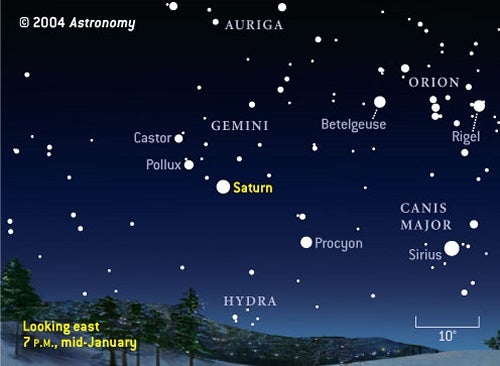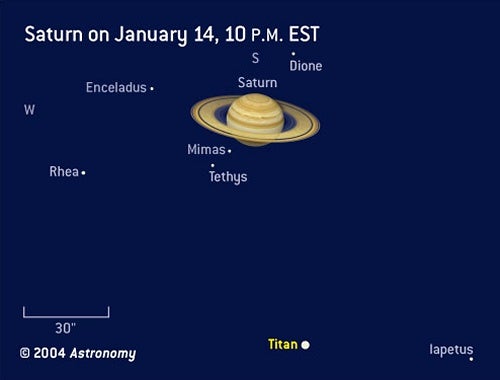Tonight, Saturn reaches its closest point to Earth and shines at its brightest, easily visible to the unaided eye among the bright winter stars. Through a telescope, Saturn is one of the most striking objects visible in the night sky — a pale sphere set within bright, broad rings.
The ringed planet reaches its closest point just 1 day before the European Space Agency’s Huygens probe plunges into the atmosphere of Saturn’s largest moon, Titan. So while people are looking at the bright planet, Huygens prepares for its historic, fateful trip to the surface mysterious moon’s surface.
Saturn is easy to find near the brightest stars of Gemini — Castor and Pollux — as darkness falls. Tonight, Saturn rises in the east at sunset, reaches its highest point in the sky at midnight, and sets in the west at dawn. Because Saturn is opposite the Sun as seen from Earth then, astronomers term this event “opposition.” Oppositions occur each time faster-moving Earth laps farther planets as they orbit around the Sun.
Saturn follows a slightly stretched-out orbit that brings it closest to the Sun every 29.5 years. It reached that point in 2003 and has been moving farther from the Sun ever since. So, during the next few weeks, the ringed planet offers observers their best views for decades to come.
At opposition, Saturn lies 750 million miles (1.2 billion kilometers) from Earth. Even at its closest, Saturn is so far away that the light we see — and data sent from the orbiting Cassini spacecraft and Huygens probe — takes 1 hour, 7 minutes to reach us.
At each opposition, we see Saturn’s beautiful ring system at slightly different angles because Saturn itself is moving around the Sun. Right now, the tilt is 23° and near its maximum, but the rings will appear less distinct at coming oppositions until 2009. At that point, Earth passes through the rings’ plane and the rings will all but disappear. They continue to open each successive year until 2016, when then the process reverses.
Amateur astronomers aren’t the only ones excited about Saturn’s opposition. The alignment between Earth, Sun, and Saturn is so good that, seen from Saturn, Earth would appear in silhouette crossing the Sun’s disk.
Astronomers plan to monitor the ringed planet from 10 observatories around the world — and with the Hubble Space Telescope — to record how the ringed planet’s icy moons brighten as sunlight strikes them face-on. Called the “opposition effect,” the moons can shine up to 20 percent brighter when Saturn, Earth, and the Sun align. Such an alignment won’t occur again until 2020.











